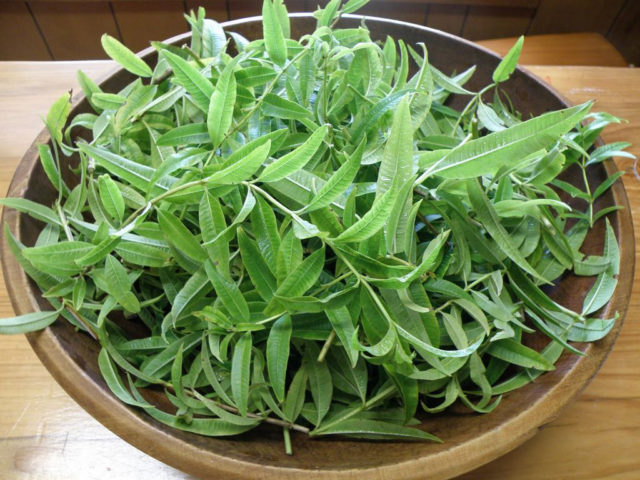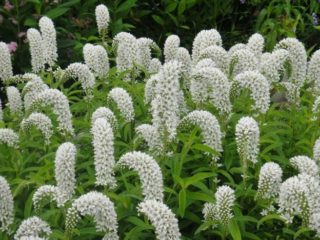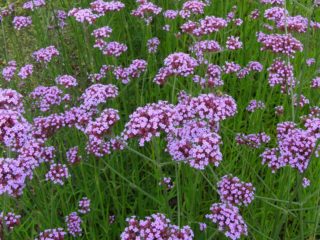Content
Lemon verbena is a representative of the Verbena family, a perennial essential oil crop with a pronounced citrus aroma of the aerial parts. It is grown in open ground in the North Caucasus for oil production. Used in folk medicine, cooking and perfume industry.
Description of lemon verbena
In its natural environment, lemon verbena grows in countries with a subtropical climate, in Russia - on the Black Sea coast, in the Stavropol and Krasnodar regions. In regions with cold climates, lemon verbena is grown in greenhouses or at home in flower pots. The plant's frost resistance is low, the maximum value is -12 0C.

Perennial evergreen shrub also known as lemon lippia
Description of the plant:
- has a spreading shape, volume and height reach two meters;
- stems are erect, with drooping tips. The structure of the shoots is rigid, the surface is smooth, dark brown;
- inflorescences are formed on the tops and from leaf axils;
- Verbena has dense foliage, the plates are oblong, narrow, lanceolate with sharp crowns and smooth edges;
- the arrangement is opposite or whorled. The surface is slightly corrugated, with a pronounced central vein;
- leaves are hard, with a citrus scent, light green;
- the spike-shaped inflorescences consist of small, simple flowers with a purple core and light pink petals;
- the root system is taprooted with numerous shoots;
- The fruit is a dry, hard drupe.
The plant blooms from July to autumn (until the first drop in temperature).
Features of reproduction
Lemon verbena is propagated by generative and vegetative methods - cuttings.
Seeds are collected at the end of the season, approximately in October. Planted in fertile substrate in early March. First place it in water for three days, then keep it in a damp cloth for 5 days in the refrigerator.
Sowing lemon verbena seeds:
- The containers are filled with a soil mixture consisting of peat and humus with the addition of sand.
- After planting, water thoroughly and cover the container with a dark film.
- Sprouts will appear in 10-15 days, during this time the containers should be at a temperature of + 25 0C.
- When the lemon verbena seeds germinate, remove the protective film and place the seedlings in a well-lit place, spray the soil with a spray bottle, since the seedlings do not tolerate excess moisture well.
- After three leaves appear, the verbena is picked.
If propagation is carried out by cuttings, the material is harvested in late spring. Shoots 10-15 cm long are cut from the top of the lemon verbena. The sections are treated with an antifungal drug and placed in Kornevin or any growth stimulating agent for 2 hours.Then they are planted in flower pots or a container with fertile soil. You can make a mini greenhouse on the site in a shaded place and cover it with film. The seedlings will be ready for transfer to a permanent location in about 30 days.

Strong specimens are selected from the total mass and planted in separate peat glasses.
Features of growing lemon verbena
Lemon verbena is planted on the site at the beginning of the growing season, when there is no threat of return frosts. Compost, peat and nitrophoska are added to the drained planting hole. A well-lit place for the plant is allocated, since the crop is sun-loving and does not respond well to shade. After placement, pinch the tops so that the bush can better form side shoots.
The soil for lemon verbena should have a neutral reaction; a slightly acidic composition is allowed.
In one area, verbena can grow for more than 10-15 years; the crop blooms 3 months after planting.
Caring for lemon verbena in open ground is as follows:
- After planting, it is recommended to mulch the root circle. This event is relevant for plants of any age. The material will help retain moisture and save the gardener from loosening the soil.
- Weeding is carried out at the beginning of the season, then the bush grows, completely displacing the weeds.
- Regular watering is necessary to keep the top layer of soil moist, but stagnation of water should not be allowed, since excess moisture can cause rotting of the roots and stems.
- In the spring, lemon verbena is fed with nitrogen; it is necessary for better formation of the aerial part. At the time of shoot formation, superphosphate and ammonium nitrate are added, and during flowering, potassium and phosphorus are given.In the fall, add organic matter.
- For the winter, verbena is cut off completely, the layer of mulch is increased and covered with straw.
Lemon verbena is ideal for growing on balconies or loggias. In stationary conditions, the plant rarely exceeds a height of 45-50 cm, so it does not take up much space.
Some tips for growing lemon verbena in a flower pot:
- The plant can be obtained from seeds or cuttings.
- The pot must be placed on a south or east window.
- At the beginning of summer, take lemon verbena to an open area, balcony or garden so that the place is not shaded.
- The crop does not like drafts and waterlogging of the soil; these features are taken into account when watering and placing.
- You can feed them at home with nitrogen-containing preparations, mineral complex fertilizers and organic matter.

In winter, lemon verbena is watered once every 2 weeks; no feeding is needed during the dormant period.
You cannot keep the pots near heating appliances if it is not possible to create the required temperature; the plant is periodically sprayed or placed in a tray with wet sand. When air humidity is low, verbena leaves dry out and fall off.
The crop is pruned by 40% in the spring, and the tops of the remaining branches are broken off. Lemon verbena shoots quickly form replacements and intensively increase green mass. During the season, you can break off the side shoots if necessary, and cut off the remaining part in the fall.
Every 2 years, lemon verbena is transplanted into a larger pot; the root system of the plant grows quickly. If the container is small, the bush begins to shed its leaves.
Benefits of Lemon Verbena
Lemon verbena is classified as a plant with medicinal properties. The main concentration of essential oils is found in the leaves and stems. The crop is grown to obtain raw materials by steam distillation. The process is labor-intensive, the yield of oils is insignificant, hence the high price of the products.
Lemon verbena contains active substances that have medicinal properties:
- terpene ketones;
- photocitral;
- alcohols;
- nerol;
- aldehydes;
- geraniol;
- polyphenols;
- caryophyllene;
- glycosides.
In Arab countries, lemon verbena oil is considered an aphrodisiac that increases libido.
The healing properties of verbena tea
To prepare the drink, crushed leaves and stems, raw or dried, are used. For 200 g of boiling water take 2 tbsp. l. raw materials. Leave for 20 minutes. Drink in the afternoon or before bed without sugar.
What are the healing properties of lemon verbena tea?
- Effectively relieves seasonal viral infections, lowers temperature, eliminates cough, and removes phlegm from the bronchi.
- Increases immunity. The high concentration of ascorbic acid in the stems and leaves of lemon verbena prevents the development of vitamin deficiency.
- Improves appetite, promotes the production of gastric secretions, and normalizes the digestion process. Tea is indicated for gastritis and peptic ulcers.
- Relieves symptoms of asthenia, restores muscle tone, has a sedative effect, relieves irritability, anxiety, improves sleep quality, and relieves headaches.
- Lemon verbena is recommended for anemia. With a heavy menstrual cycle, it has an analgesic effect.
- The culture is used for skin diseases; the chemical composition of verbena oil includes bactericidal substances that relieve itching and inflammation.
- Used in the treatment of urological diseases. A diuretic removes stones from the ureters and kidneys;
- Verbena restores liver tissue cells.
Tea is good for high cholesterol. It has a cleansing effect and removes toxins from the body.

The green mass of lemon verbena can be used fresh, dried in large quantities or stored in the freezer in a freezer bag.
Uses of Lemon Verbena
The beneficial properties of the culture are used in alternative medicine and in the perfume industry. Oils are often used in aromatherapy for relaxation and recuperation, and are used in saunas and steam baths.
In folk medicine
In folk medicine, decoctions and tinctures of the leaves and stems of lemon verbena are used. For this purpose, fresh or prepared and dried raw materials are taken. You can use the flowers of the plant, but the concentration of active substances in them is lower.
To treat the liver or spleen, a decoction is made, which is also effective for cholesterol plaques:
- For 500 ml of water, take 2 tbsp. l. crushed dry raw materials.
- Place on fire and boil for 3 minutes.
- Cover the container and leave for 12 hours; it is better to make the decoction in the evening.
This is the daily norm, it is divided into 2 parts, the first portion is used after lunch, the second before bed. Course 14 days.
To improve the walls of blood vessels during thrombosis or atherosclerosis, make the following infusion of verbena:
- Pour 3 tsp into a 1 liter thermos. dry raw materials.
- Pour boiling water over.
- Leave for 6 hours, strain and put in the refrigerator.
Drink 1 tbsp during the daytime. l., maintaining an interval of 2 hours.When the tincture is over, take a daily break and repeat the procedure.
General strengthening infusion of lemon lipia, relieving fatigue and nervous tension:
- Pour 2 tbsp into a glass. l. dry verbena.
- Fill with boiling water and close.
- Leave for 3 hours, filter.
Divide into 2 doses, the first dose is used in the afternoon, the second before bedtime. Course – 7 days.
Inflammatory processes in the urinary system are treated with the following decoction:
- Pour 50 g of dry lemon verbena into a container of water (500 ml).
- Bring to a boil, set aside.
- Leave for 3 hours, filter.
Divide into 5 doses and drink every 2 hours, the course of treatment takes 5 days.
In aromatherapy
Alternative medicine uses lemon verbena oil for massage, which improves blood circulation by normalizing the functions of the vascular system. Eliminates spasms in the blood vessels of the brain, relieves pain, dizziness, and nausea. Include lemon lipia oil in a complex of essential compositions in saunas or baths. Use helps relieve fatigue, nervous tension, improves mood and quality of sleep.
In cosmetology
Lemon verbena oil is added to creams and lotions with anti-cellulite effects.

An essential oil substance is used in perfume to create a subtle citrus aroma.
Products based on natural raw materials restore skin elasticity. Has a tightening effect. Relieves irritation and inflammation on the epidermis. Shampoos containing lemon verbena restore hair structure and get rid of dandruff. Shower gels with lemon lipia oil tone muscles and eliminate excessive sweating.
At home
Lemon verbena oil is used for wet cleaning of living spaces.Add a few drops of essential substance to water and wipe furniture, frames, doors, and use for cleaning the bathroom. Citrus aroma eliminates unpleasant odors of mold and tobacco smoke.
The pungent lemon smell repels insects, especially mosquitoes. A few drops of verbena are applied to cotton pads and placed near open windows and balcony doors; these activities are especially relevant at night; the scented substance will improve sleep and repel insects.
Restrictions and contraindications
It is not recommended to use tea, decoctions or tinctures of lemon verbena in the following cases:
- if you have an allergic reaction to this herb;
- children under 10-12 years old;
- during pregnancy and lactation;
- for asthma;
- with unstable blood pressure.
If lemon lipia oil is added independently to a cream or lotion, start with a minimum dosage. Essential compounds can cause irritation on sensitive skin and the effect will be the opposite of the desired one.
When and How to Harvest Lemon Verbena Leaves
By the flowering period, lemon verbena accumulates all the necessary substances, at this time their concentration is the highest. Raw materials are harvested from July to September. Stems, flowers and leaves are separated. The green mass is cut into small pieces and dried in a room with good ventilation. When the raw materials are ready, they are mixed, placed in a canvas or paper bag, and stored in a dry place. You can not cut the parts, but collect the stems with leaves in a bunch and hang them in a dark place.
Conclusion
Lemon verbena is a perennial herbaceous shrub with a distinct citrus scent.Cultivated on a production scale for the perfume industry, essential oils are obtained from the green mass. The plant is suitable for growing in flower pots. The culture has medicinal properties; the leaves and stems are used in alternative medicine.








